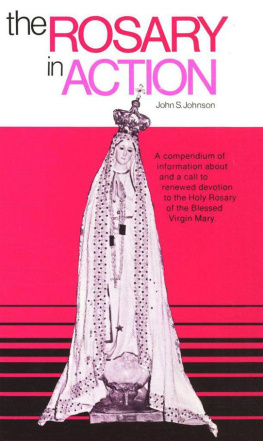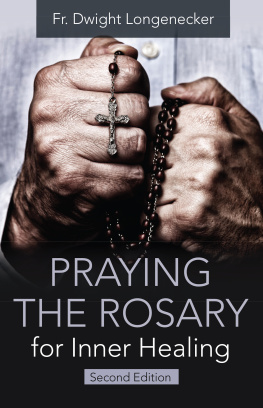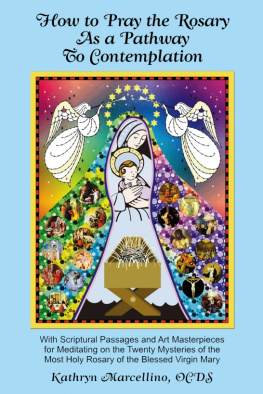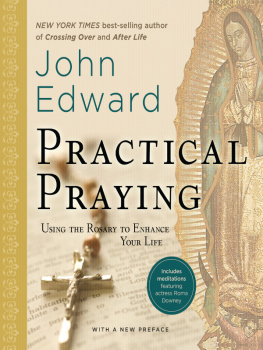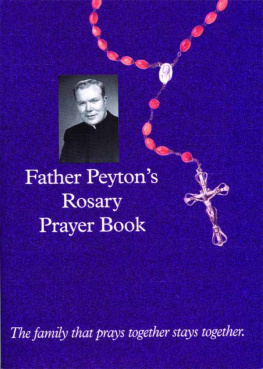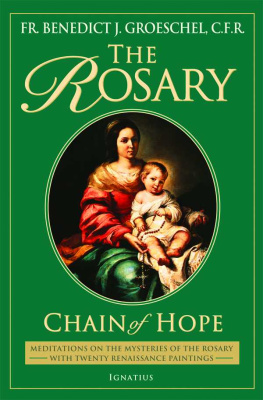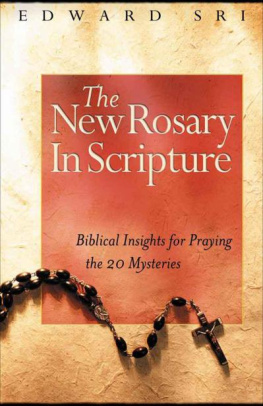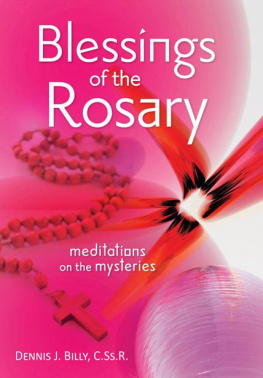John S. Johnson - The Rosary In Action
Here you can read online John S. Johnson - The Rosary In Action full text of the book (entire story) in english for free. Download pdf and epub, get meaning, cover and reviews about this ebook. year: 1977, publisher: TAN Books, genre: Religion. Description of the work, (preface) as well as reviews are available. Best literature library LitArk.com created for fans of good reading and offers a wide selection of genres:
Romance novel
Science fiction
Adventure
Detective
Science
History
Home and family
Prose
Art
Politics
Computer
Non-fiction
Religion
Business
Children
Humor
Choose a favorite category and find really read worthwhile books. Enjoy immersion in the world of imagination, feel the emotions of the characters or learn something new for yourself, make an fascinating discovery.
- Book:The Rosary In Action
- Author:
- Publisher:TAN Books
- Genre:
- Year:1977
- Rating:3 / 5
- Favourites:Add to favourites
- Your mark:
- 60
- 1
- 2
- 3
- 4
- 5
The Rosary In Action: summary, description and annotation
We offer to read an annotation, description, summary or preface (depends on what the author of the book "The Rosary In Action" wrote himself). If you haven't found the necessary information about the book — write in the comments, we will try to find it.
The Rosary In Action — read online for free the complete book (whole text) full work
Below is the text of the book, divided by pages. System saving the place of the last page read, allows you to conveniently read the book "The Rosary In Action" online for free, without having to search again every time where you left off. Put a bookmark, and you can go to the page where you finished reading at any time.
Font size:
Interval:
Bookmark:
The Rosary in Action
John S. Johnson
IMPRIMATUR
Joseph E. Ritter, S.T.D.
Archbishop of St. Louis
July 1, 1954
Library of Congress Catalog Card Number: 54-8388
Copyright 1954 by B. Herder Book Co.
Copyright 1977 by TAN Books and Publishers, Inc.
Originally published by B. Herder Book Co., St. Louis, Mo.
TAN BOOKS
Charlotte, North Carolina
1977
Contents
Foreword
THE Confraternity of the Most Holy Rosary has been entrusted by the Holy See to the Dominican Order. That is fitting, since well established tradition ascribes the origin of this Confraternity to St. Dominic, who preached the first Rosary crusade in France in 1206. Many popes have called the Rosary Confraternity the highest and noblest of the societies of Christ's Church. Pope Leo XIII exhorted "all priests who are charged with the care of soulsnot only the Sons of St. Dominic, to whom by virtue of their Order pertains the leading part in this apostolateto be zealous in preaching, founding, and enlarging this Confraternity. They will learn that the faithful will be eager to enroll themselves, and to take advantage of the great spiritual benefits in which consist the very meaning and motive of the Rosary." The words of the Holy Father were prophetic in regard to the Church in the United States, where more than four thousand branches of the Confraternity have been established.
The main purpose of this Society is to join the members of the mystical body in a bond of love of God, through the intercession of Our Blessed Mother. There is no doubt that the Rosary is her favorite prayer. The author of The Rosary in Action cites many instances of this truth. He points out that American Catholics in ever increasing numbers have come to realize the power and the beauty of the Rosary. Members of the Confraternity have learned for themselves that this devotion provides "a map of human life, a sublime social pattern; that it is a synopsis of Christian doctrine, an antidote for confusion and despair."
In The Rosary in Action Mr. Johnson lays emphasis on the essential meaning of the Rosary devotion. When Our Lady commanded St. Dominic to preach the Rosary the new thing which was added was meditation on the mysteries. St. Pius V and many other popes have called attention to the necessity of meditation as an accompaniment of the vocal prayers of the Rosary. As the author states, many Catholics who love and pray the Rosary are not aware of this requirement. Moreover, some do not know that meditation is necessary to gain the indulgences of the Dominican blessing (although it is not required for the Apostolic, Brigittine, and Crozier indulgences). When they learn of this requirement many clients of Mary are frightened, appalled by the seeming enormity of the task of meditation.
Speaking as a layman from his own experiences, Mr. Johnson first allays such fears by showing that all that is required to gain the indulgences is the sincere effort to meditate, even though that effort fails. He then lays bare the beautiful simplicity and the tremendous benefits of Rosary meditation. He demonstrates to his fellow Catholics how they can meditate, and provides excellent material for each of the fifteen mysteries. Meditation is not necessarily a stupendous work: it is only "the loving thought of the divine plan for man's redemption, as this is revealed in the life and teachings of Jesus Christ."
We recommend this devout guidebook of the Rosary to all members of the Rosary Confraternity. The author has done great service in furthering the work proposed by Pope Leo XIII, to help all to know and to love the Rosary. Mr. Johnson makes application of the words of the Holy Father to our own times: "No remedy is better adapted to turn men away from the evil of these days, and to bring them back to Christ, who is the Way, the Truth, and the Life.... This method of prayerproperly carried out as it was instituted by St. Dominic, through meditation on the truths of salvation, and with prayer for the intercession of that Virgin to whom it is given to destroy all heresieswill cause a return of faith, piety, and love, so that the projects and devices of evil ones will fall to pieces."
ROBERT W. BARRON, O.P., S.T.D. | |
Provincial Promoter of the Rosary | |
| Chicago, Illinois | Confraternity |
PART ONE
The Message of the Rosary
CHAPTER 1
Some Personal Experiences
IT IS not so long ago that saying the Rosary was a severe trial to me. We said Rosaries at school, of course, and I have as a boy even led in the saying of the Rosary from the sanctuary, half scared to death at the sound of my own voice speaking out loud. That was in the second decade of the twentieth century just before the outbreak of the First World War; just at the time when the secularized world was lifting its head highest in pride. All the ills we are now suffering from were prepared for us then, but no one seemed to know the world was in great danger except the Holy Father in Rome. Pius IX had called attention to the growing threat of Communism before the middle of the previous century; Leo XIII, the great Pope of the Rosary, had written time after time, begging men to say the Rosary to correct world evils; and the fight was continued by the now St. Pius X, who had recently revived the practice of early and frequent Communion. Meanwhile the world was pretty well satisfied with itself; intoxicated with the thought of Human Progress (spelled with capitals) having outmoded religion (spelled with a small "r"). I believe we said the Rosary in those days mainly because Leo XIII had asked that it be said every day during October, but I am not aware of much active Rosary propaganda.
Nowadays one would not say the Rosary as we did then. I remember not much effort was made even to announce the name of the mysteries. We just went ahead and said the vocal prayers. I notice as I travel around the state that when I drop in here or there for a Mass of a morning that they are now more careful of these things, and often the treble voice of some poor half-scared kid will even add a line or so of meditation as well as give the name of the mystery.
I brought back with me the ruins of the steel beads which I carried through the first World War. One fragment contained almost two decades; the second piece yielded almost a decade; another piece was a decade and a few beads over. In all there were four decades and two beads over I brought back. The triangular bit of metal that held the loop of the beads and connected with the auxiliary beads and the crucifix was broken, and the pendent beads were gone. I say "triangular bit of metal" for in 1917 there were not many rosaries that used scapular medals as dividers on rosaries. The scapular medal was just newly approved then, and most of us were vague about how to substitute the medal. I know that I still used the traditional five scapulars even during the war. I found out later I had rights of self-enrollment in any and all the scapulars while I was in the armed services, simply by taking up the medal, which had to be blessed, of course. I still have the scapulars I wore, and they are in a deplorable state from dirt, sweat, lice, and the subsequent runs through the de-lousing operations. When the scapulars broke beyond repair I simply put them in my breast pocket, not considering getting a new pair, just as I kept on carrying the broken rosary. There is always a danger in spiritual affairs of getting an attachment to the material symbols of the devotion and of cherishing them for their own sake. The thing to do was to have disposed of the scapulars and the beads and to have got new ones, or at least to have had the rosary repaired. Such attachments are inordinate; they bring reproach from unbelievers who say that we cultivate such things as charms, or as lucky pieces. This is sometimes true of misguided individuals, but the Church frowns on making the material carrier of the devotion the important consideration.
Next pageFont size:
Interval:
Bookmark:
Similar books «The Rosary In Action»
Look at similar books to The Rosary In Action. We have selected literature similar in name and meaning in the hope of providing readers with more options to find new, interesting, not yet read works.
Discussion, reviews of the book The Rosary In Action and just readers' own opinions. Leave your comments, write what you think about the work, its meaning or the main characters. Specify what exactly you liked and what you didn't like, and why you think so.

